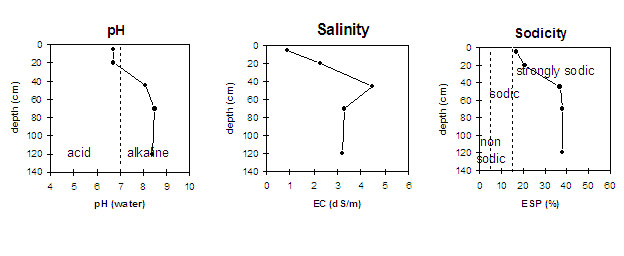LP18
DRAFT PROFILE ONLY | |
| Location: Pyramid Hill | Australian Soil Classification: |
| Northcote Factual Key: | Great Soil Group: |
| General Landscape Description: Flat plain. Vegetation includes salt tolerant plants and Red Weed (?). | |
| Local Name: Yarrawolla Loam | |
Soil Profile Morphology
Surface Soil
| A1 | 0-10 cm | Brown (7.5YR4/4); fine sandy clay loam; hardsetting surface condition with surface flake; weak coarse blocky structure; strong consistence dry; pH 6.7; sharp and smooth change to: | |
Subsoil | |||
| B21 | 10-30 cm | Dark reddish brown (5YR3/4); medium clay; strong coarse angular blocky structure; strong consistence dry, friable consistence moist; at 10-15 cm depth there are a few (2-10%) ironstone nodules (1-2 mm in size) with staining around shiny ped faces; pH 6.7; clear and smooth change to: | |
| B22 | 30-60 cm | Yellowish red (5YR5/6); heavy clay; strong coarse blocky, breaking down to strong fine blocky structure; weak consistence moist; contains very few (<2%) ironstone nodules (1-2 mm in size); pH 8.1; gradual change to: | |
| B23 | 60-80 cm | Brown (7.5YR4/4) with yellowish red (5YR5/6) mottles; light medium clay; strong coarse blocky structure; weak consistence moist; contains a few (2-10%) carbonate nodules (<1 cm in size) as well as very few (<2%) ironstone nodules (1-2 mm in size); pH 8.5; clear change to: | |
| B24 | 80-100 cm | Strong brown (7.5YR4/6); light clay; strong blocky structure; weak consistence moist; contains a few (2-5%) carbonate nodules (<1 cm in size); gradual change to: | |
| B25 | 100+ cm | Strong brown (7.5YR5/6); light medium clay; strong blocky structure; weak consistence moist; contains a few (2%) fine soft dark segregations; pH 8.4. | |
Key Profile Features
- Hardsetting surface condition with surface flake.
- Strong texture contrast between surface (A1) horizon and subsoil (B21) horizon.
- Accumulation of carbonates within the subsoil.
Soil Profile Characteristics
 |
Management Considerations:
Whole Profile
- The profile is highly saline increasing to extreme at 20 cm and is likely to restrict the growth of salt sensitive plant species (e.g. faba beans, linseed, chickpeas and lupins).
- A positive feature of this profile is that it has a moderate inherent fertility throughout which is beneficial to plant growth.
Surface (A) Horizon
- The surface (A1) horizon has a very high fine sand content and is hardsetting when dry. When cultivated in a dry condition it will become ‘powdery’ and subsequent rainfall may result in surface sealing occurring. The levels of organic carbon measured at the pit site is low (this may or may not be representative of the whole paddock). Organic matter levels will decline if cropping takes place and can be improved by adopting practices such as residue retention, minimum tillage and utilising pasture rotations. Increased organic matter will both improve aggregation as well as assist in the low water holding capacity and moderate inherent fertility of this surface soil.
- The surface (A1) horizon is strongly sodic and has a low exchangeable calcium to magnesium ratio (0.9) with slight dispersion (strong after remoulding). This indicates that tillage or over-stocking of the soil whilst in a moist to wet condition may result in structural degradation (e.g. surface sealing, increased cloddiness) occurring. Raindrop action on bare soil may have a similar effect, so it is important to maintain surface cover. Gypsum application may assist in improving surface soil structural conditions on such soils.
- The levels of total nitrogen measured at this pit site is moderate. However, this is best assessed by taking a bulked sample from across the paddock.
Subsoil (B) Horizons
- The densely and coarsely structured upper subsoil (B21) is strongly sodic with a low exchangeable calcium to magnesium ratio (0.5) becoming extremely sodic with depth. The extremely high salinity level has probably contributed to the decrease in dispersion to nil (only slight after remoulding) and is not likely to restrict water movement as significantly as would occur if the soil was not saline. Nevertheless, subsoil permeability will be low due to the low porosity of the clayey horizons.
Comments:
- Tile irrigation research being undertaken at this site.
- High surface salt levels a few metres away, makes the surface condition very loose.


